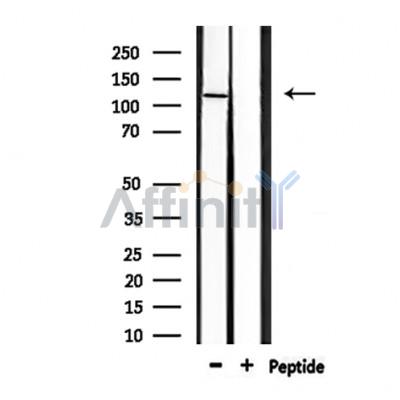GRIA4 Antibody - #DF7951
| Product: | GRIA4 Antibody |
| Catalog: | DF7951 |
| Description: | Rabbit polyclonal antibody to GRIA4 |
| Application: | WB IHC IF/ICC |
| Reactivity: | Human, Mouse, Rat, Monkey |
| Prediction: | Pig, Bovine, Horse, Sheep, Rabbit, Dog, Chicken, Xenopus |
| Mol.Wt.: | 120 kDa; 101kD(Calculated). |
| Uniprot: | P48058 |
| RRID: | AB_2841352 |
Related Downloads
Protocols
Product Info
*The optimal dilutions should be determined by the end user. For optimal experimental results, antibody reuse is not recommended.
*Tips:
WB: For western blot detection of denatured protein samples. IHC: For immunohistochemical detection of paraffin sections (IHC-p) or frozen sections (IHC-f) of tissue samples. IF/ICC: For immunofluorescence detection of cell samples. ELISA(peptide): For ELISA detection of antigenic peptide.
Cite Format: Affinity Biosciences Cat# DF7951, RRID:AB_2841352.
Fold/Unfold
AMPA 4; AMPA selective glutamate receptor 4; AMPA-selective glutamate receptor 4; AMPA4; GluA 4; GluA4; GluR 4; GluR D; GluR-4; GluR-D; GluR4; GLUR4C; GLURD; Glutamate receptor 4; Glutamate receptor ionotrophic AMPA 4; Glutamate receptor ionotropic; GRIA 4; Gria4; GRIA4_HUMAN;
Immunogens
A synthesized peptide derived from human GRIA4, corresponding to a region within the internal amino acids.
- P48058 GRIA4_HUMAN:
- Protein BLAST With
- NCBI/
- ExPASy/
- Uniprot
MRIISRQIVLLFSGFWGLAMGAFPSSVQIGGLFIRNTDQEYTAFRLAIFLHNTSPNASEAPFNLVPHVDNIETANSFAVTNAFCSQYSRGVFAIFGLYDKRSVHTLTSFCSALHISLITPSFPTEGESQFVLQLRPSLRGALLSLLDHYEWNCFVFLYDTDRGYSILQAIMEKAGQNGWHVSAICVENFNDVSYRQLLEELDRRQEKKFVIDCEIERLQNILEQIVSVGKHVKGYHYIIANLGFKDISLERFIHGGANVTGFQLVDFNTPMVIKLMDRWKKLDQREYPGSETPPKYTSALTYDGVLVMAETFRSLRRQKIDISRRGNAGDCLANPAAPWGQGIDMERTLKQVRIQGLTGNVQFDHYGRRVNYTMDVFELKSTGPRKVGYWNDMDKLVLIQDVPTLGNDTAAIENRTVVVTTIMESPYVMYKKNHEMFEGNDKYEGYCVDLASEIAKHIGIKYKIAIVPDGKYGARDADTKIWNGMVGELVYGKAEIAIAPLTITLVREEVIDFSKPFMSLGISIMIKKPQKSKPGVFSFLDPLAYEIWMCIVFAYIGVSVVLFLVSRFSPYEWHTEEPEDGKEGPSDQPPNEFGIFNSLWFSLGAFMQQGCDISPRSLSGRIVGGVWWFFTLIIISSYTANLAAFLTVERMVSPIESAEDLAKQTEIAYGTLDSGSTKEFFRRSKIAVYEKMWTYMRSAEPSVFTRTTAEGVARVRKSKGKFAFLLESTMNEYIEQRKPCDTMKVGGNLDSKGYGVATPKGSSLRTPVNLAVLKLSEAGVLDKLKNKWWYDKGECGPKDSGSKDKTSALSLSNVAGVFYILVGGLGLAMLVALIEFCYKSRAEAKRMKLTFSEAIRNKARLSITGSVGENGRVLTPDCPKAVHTGTAIRQSSGLAVIASDLP
Predictions
Score>80(red) has high confidence and is suggested to be used for WB detection. *The prediction model is mainly based on the alignment of immunogen sequences, the results are for reference only, not as the basis of quality assurance.
High(score>80) Medium(80>score>50) Low(score<50) No confidence
Research Backgrounds
Receptor for glutamate that functions as ligand-gated ion channel in the central nervous system and plays an important role in excitatory synaptic transmission. L-glutamate acts as an excitatory neurotransmitter at many synapses in the central nervous system. Binding of the excitatory neurotransmitter L-glutamate induces a conformation change, leading to the opening of the cation channel, and thereby converts the chemical signal to an electrical impulse. The receptor then desensitizes rapidly and enters a transient inactive state, characterized by the presence of bound agonist. In the presence of CACNG4 or CACNG7 or CACNG8, shows resensitization which is characterized by a delayed accumulation of current flux upon continued application of glutamate.
Palmitoylated. Depalmitoylated upon glutamate stimulation. Cys-611 palmitoylation leads to Golgi retention and decreased cell surface expression. In contrast, Cys-837 palmitoylation does not affect cell surface expression but regulates stimulation-dependent endocytosis (By similarity).
Phosphorylated at Ser-862 by PRKCG; phosphorylation increases plasma membrane-associated GRI4 expression.
Cell membrane>Multi-pass membrane protein. Cell junction>Synapse>Postsynaptic cell membrane>Multi-pass membrane protein. Cell projection>Dendrite.
Note: Interaction with CNIH2, CNIH3 and PRKCG promotes cell surface expression.
The M4 transmembrane segment mediates tetramerization and is required for cell surface expression.
Belongs to the glutamate-gated ion channel (TC 1.A.10.1) family. GRIA4 subfamily.
Research Fields
· Environmental Information Processing > Signal transduction > cAMP signaling pathway. (View pathway)
· Environmental Information Processing > Signaling molecules and interaction > Neuroactive ligand-receptor interaction.
· Human Diseases > Substance dependence > Amphetamine addiction.
· Organismal Systems > Environmental adaptation > Circadian entrainment.
· Organismal Systems > Nervous system > Retrograde endocannabinoid signaling. (View pathway)
· Organismal Systems > Nervous system > Glutamatergic synapse.
· Organismal Systems > Nervous system > Dopaminergic synapse.
Restrictive clause
Affinity Biosciences tests all products strictly. Citations are provided as a resource for additional applications that have not been validated by Affinity Biosciences. Please choose the appropriate format for each application and consult Materials and Methods sections for additional details about the use of any product in these publications.
For Research Use Only.
Not for use in diagnostic or therapeutic procedures. Not for resale. Not for distribution without written consent. Affinity Biosciences will not be held responsible for patent infringement or other violations that may occur with the use of our products. Affinity Biosciences, Affinity Biosciences Logo and all other trademarks are the property of Affinity Biosciences LTD.


